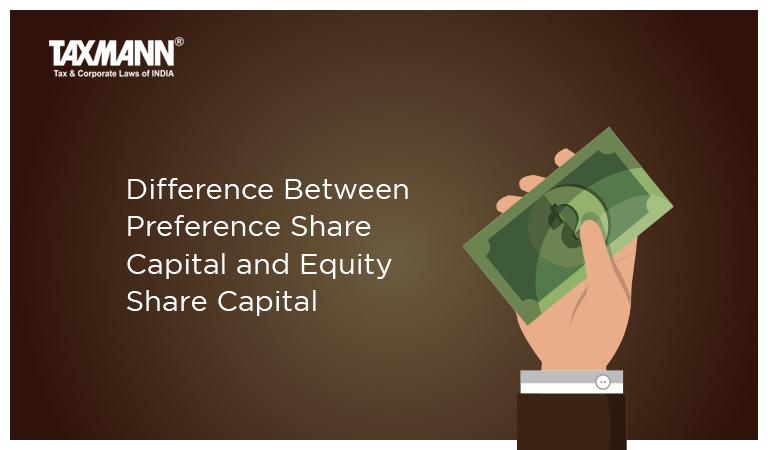Difference Between Preference Share Capital and Equity Share Capital
- Blog|Company Law|
- 3 Min Read
- By Taxmann
- |
- Last Updated on 27 April, 2023

Table of Content
- Preference Shares
- Preference shares as cumulative or non-cumulative
- Conversion of already issues equity shares into redeemable preference shares
- Redeemable preference shares with a redemption period of 20 years.
- Difference between Preference Share Capital vs Equity Share Capital?
1. What are Preference Shares?
As per Section 43(2) of the Companies Act, 2013, preference share capital with reference to any company limited by shares, means that part of the issued capital of the company which carries or would carry a preferential right with respect to-
(a) payment of dividend, either as a fixed amount or at a fixed rate, and
(b) repayment in the case of a winding up or repayment of capital specified in the memorandum or articles of the company.
2. Whether Preference shares are cumulative or non-cumulative?
-
- A cumulative preference share confers a right on its holder to claim fixed dividend of the past and the current year and out of future profits.
- The dividend keeps on accumulating until it is fully paid.
- The non-cumulative preference share gives right to its holder to a fixed amount or a fixed percentage of dividends out of the profits of each year.
- If no profits are available in any year, the shareholders get nothing, nor can they claim, unpaid dividend in any subsequent year.
3. Can issues equity shares be converted into redeemable preference shares?
As per Chowgule & Co. (P.) Ltd. 1972 Tax LR 2163, St. James Court Estates Ltd. [1944] Ch. 6, it was held that where the equity shares are to be converted into redeemable preference shares it was necessary to adopt the process of Reduction of Capital under Section 66 of the Companies Act, 2013.
Equity shares already issued can be converted into redeemable preference shares only when procedure of Reduction Of Capital under Section 66 of the Companies Act, 2013 is complied with.
4. What is meant by redeemable preference shares with a redemption period of 20 years?
-
- Section 55 (1) states that no company limited by shares shall issue any preference shares which are irredeemable.
- Section 55(2) further states that a company limited by shares may, if so authorised by its articles, issue preference shares which are liable to be redeemed within a period not exceeding twenty years from the date of their issue subject to such conditions as may be prescribed.
- Exception: Issue and redemption of preference shares by company in infrastructure projects:-
- A company engaged in the setting up and dealing with of infrastructural projects may issue preference shares for a period exceeding twenty years but not exceeding thirty years, subject to the redemption of a minimum ten percent of such preference shares per year from the twenty first year onwards or earlier, on proportionate basis, at the option of the preference shareholders.
- The term ‘‘infrastructure projects’’ means the infrastructure projects specified in Schedule VI.
5. What is the difference between Preference Share Capital vs Equity Share Capital?
The main points of distinction between preference and equity share capital:
| Points | Equity Share Capital | Preference Share Capital |
| Preference in Dividend Payment | The dividend on equity shares is paid only after the preference dividend has been paid. | Shareholders get a preference in dividend payment over equity shareholders. |
| In case of winding-up | Shareholders get payment of capital after the payment of capital to preference shareholders. | Shareholders get preference in capital payment in winding-up over equity shareholders. |
| Rate of dividend | Depends upon the amount of profit available and the funds requirements of the Company. | Entitled to a fixed rate of dividend. |
| Dividend Accumulation | Cannot be cumulative. | May be cumulative for cumulative preference shares. |
| Redemption | No redemption of equity shares except under a scheme involving reduction of capital. | Redeemable preference shares may be redeemed by the Company. |
| Voting rights | An equity shareholder can vote on all matters affecting the company. | A preference shareholder cannot vote on all resolution. |
Also Read:
What is the difference between ESOS and ESOP?
Key Terms of Companies Act 2013
Disclaimer: The content/information published on the website is only for general information of the user and shall not be construed as legal advice. While the Taxmann has exercised reasonable efforts to ensure the veracity of information/content published, Taxmann shall be under no liability in any manner whatsoever for incorrect information, if any.

Taxmann Publications has a dedicated in-house Research & Editorial Team. This team consists of a team of Chartered Accountants, Company Secretaries, and Lawyers. This team works under the guidance and supervision of editor-in-chief Mr Rakesh Bhargava.
The Research and Editorial Team is responsible for developing reliable and accurate content for the readers. The team follows the six-sigma approach to achieve the benchmark of zero error in its publications and research platforms. The team ensures that the following publication guidelines are thoroughly followed while developing the content:
- The statutory material is obtained only from the authorized and reliable sources
- All the latest developments in the judicial and legislative fields are covered
- Prepare the analytical write-ups on current, controversial, and important issues to help the readers to understand the concept and its implications
- Every content published by Taxmann is complete, accurate and lucid
- All evidence-based statements are supported with proper reference to Section, Circular No., Notification No. or citations
- The golden rules of grammar, style and consistency are thoroughly followed
- Font and size that’s easy to read and remain consistent across all imprint and digital publications are applied



 CA | CS | CMA
CA | CS | CMA
